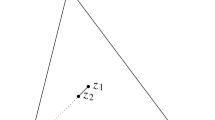Summary
LetP be ann-dimensional polyhedron and let\(b(P) = \sum\limits_{q = 1}^m {\langle X_1^q , \ldots ,X_n^q \rangle } \) be the oriented boundary ofP in terms of the oriented (n−1)-simplexesS q =〈X q1 ,...,X qn 〉,q=1,...,m. LetF=(f 1,...,f n):P→R n, and assumeF(X)≠θ forX∈b(P). For each 〈X q1 ,...,X qn 〉∈b(P) define a matrix ℛ(S q F) by setting the entry in thei-th row,j-th column of ℛ(S q F) equal to 1 if sgn(f j(X qi ))≠1 and 0 if sgn(f j(X qi ))=−1, where sgn(y)=1 ify≧0, and sgn(y)=−1 otherwise. To each such matrix ℛ(S q F) assign a number (ℛ(S q F)) in the following way: Set Par (ℛ(S q F))=+1 if the entries on and below the main diagonal of ℛ(S q F) are 1 and the entries one row above the main diagonal are 0. Also set Par (ℛ(S q F))=1 if ℛ(S q F) can be put into this form by an even permutation of its rows, and set Par (ℛ(S q F))=−1 if ℛ(S q F) can be put into form by an odd permutation of rows. Set Par (ℛ(S q F))=0 for all other matrices ℛ(S q F). Then, under rather general hypotheses and assuming diameter of eachS q ∈b(P) is small, the topological degree ofF at θ relative toP is given by:
The assumptions are identical to those used by Stenger (Numer. Math. 25, 23–28).
Use of the characterization is illustrated, an algorithm for automatic computation is presented, and an application of this algorithm to finding roots ofF(X)=θ is explained. The degree computation algorithm requires storage of a number of (n−1)-simplexes proportional to logn, and sgn(f j(S q i ) is evaluated once at most for eachi,j, andq.
Similar content being viewed by others
References
Alexandroff, P., Hopf, H.: Topologie, Chelsea, N.Y. 1935
Allgower, E.L., Jeppson, M.: The approximation of solutions of nonlinear elliptic boundary value problems having several solutions, Springer lecture notes333, 1–20 (1973)
Allgower, E.L., Keller, K.L.: A search routine for a sperner simplex, Computing8, 157–165 (1971)
Cronin, J.: Fixed points and topological degree in nonlinear analysis. Amer. Math. Soc. Surveys II, 1964
Erdelsky, P.J.: Computing the Brouwer degree inR 2, Math. Comp.22, 133–137, 1973
Greenberg, M.: Lectures on algebraic topology, W.A. Benjamin, N.Y. 1967
Hadamard, J.: Sur quelques applications de l'indice de Kronecker, Herman, Paris 1910
Jeppson, M.: A search for fixed points of a continuous mapping, Mathematical topics in economic theory and computation, 122–128, SIAM, Philadelphia 1972
Kearfott, R.B.: Computing the degree of maps and a generalized method of bisection, Ph.D. dissertation, University of Utah, S.L.C. 1977
O'Neil, T., Thomas, J.: The calculation of the topological degree by quadrature, SIAM J. Numer. Anal.12, 673–680 (1975)
Rheinboldt, W.C., Ortega, S.M.: Iterative solution of nonlinear equations in several variables, N.Y.: Academic Press 1970
Scarf, H.: The approximation of fixed points of a coninuous mapping, SIAM J. Appl. Math.15, 1328–1343 (1967)
Stenger, F.: Computing the topological degree of a mapping inR 2, Numer. Math.25, 23–38 (1975)
Stynes, M.: Ph.D. dissertation, Univ. of Oregon, Corvallis 1977
Author information
Authors and Affiliations
Rights and permissions
About this article
Cite this article
Kearfott, B. An efficient degree-computation method for a generalized method of bisection. Numer. Math. 32, 109–127 (1979). https://doi.org/10.1007/BF01404868
Received:
Issue Date:
DOI: https://doi.org/10.1007/BF01404868




